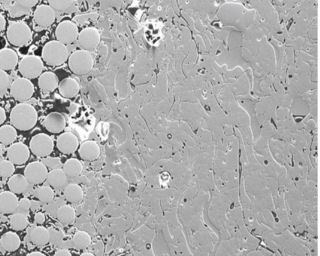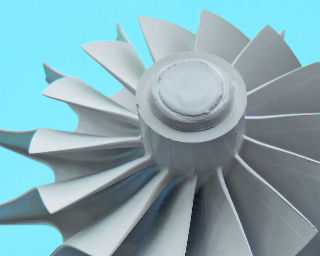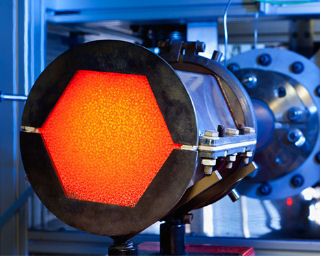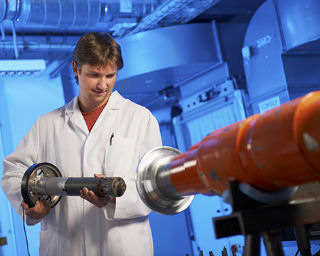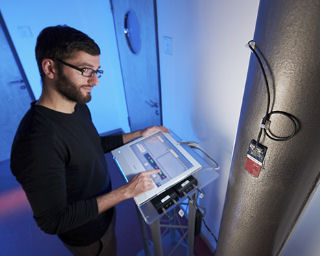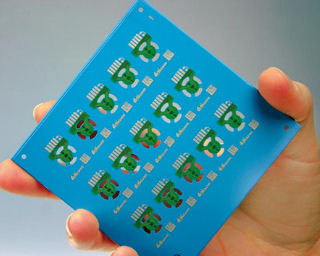
Mechanical and Automative Engineering

Areas of application
Wear and corrosion resistance
Due to their remarkable wear resistance in an aqueous or a chemically aggressive environment, ceramic materials are frequently integrated into the core elements of modern technological processes. Thus, they are superbly suited for use in bearings, sealings, valves and pumps. Fraunhofer IKTS is working on new hard and ultra-hard materials, silicon carbide and silicon nitride ceramics, ceramics made of sub-μm corunds, as well as plasma-sprayed, wear-resistant coatings that increase durability and open-up new fields of application.
Tools
Modern production requires tools that deliver a high degree of process stability. Fraunhofer IKTS develops the commensurate materials and production processes, ranging from hardmetals and cermets to super-hard materials and wear-resistant ceramics, as well as thin CVD hard material coatings. Using modern joining techniques, it deploys these materials in reliable and highperformance cutting tools and forming dies. Fraunhofer IKTS assists both manufacturers and consumers in the selection of the cutting materials, as well as their customized production. In addition, the team at Fraunhofer IKTS is developing abrasive grains with ultrafine microstructures and optimized mechanical, thermal and chemical stability to boost grinding performance considerably.
High-temperature components
High-performance ceramics are especially well suited for hightemperature processes and parts subjected to severe thermomechanical loads, since these ceramics almost never change their strength and stiffness under these conditions. By applying monolithic ceramics and fiber composite materials, hightemperature processes can be made more energy-efficient and sustainable. In addition to materials and processes to manufacture high-temperature components, Fraunhofer IKTS is developing new environmental barrier coatings based on oxide and non-oxide ceramic systems. Other efforts focus on cellular ceramic structures for porous burners and innovative reactors, as well as on electric heaters made of ceramics to attain extremely high power densities.
Related Links
Exhaust gas treatment
Ceramics have been used for many years as catalyst carriers and particle filters for treating exhaust gases from mobile and stationary combustion engines fulfilling more and more demanding specifications. Fraunhofer IKTS is developing porous and cellular ceramics as well as catalytic functionalizations for particle filtration (DPT, GPF), DeNOx catalysis (LNT, SCR) and for combined systems (DOC, TWC). The institute offers filter materials with optimized separation and pressure-loss properties, as well as greater ash storage capacity and additional functional components for the exhaust gas system. Naturally, the institute has a rich and broad spectrum of techniques for specific testing and analyses.
Test systems
Fraunhofer IKTS is the strategic partner for producers of test systems in the areas of mechanical and systems engineering. Beyond numerous standard test procedures, IKTS is certified to offer in-house developed specific test services for characterization, diagnostics and quality assurance. By interlinking electronics with software development, simulation, mechanics and system production, sophisticated test solutions can be delivered both efficiently and on schedule. As a result, customer processes are supported holistically, from development to validation. A traditional focus is on application-specific solutions for material diagnostics by the use of ultrasound, particularly or railroad engineering. The systems engineered for this purpose are used to inspect high-speed train axles throughout the world.
Fraunhofer IKTS delivers eddy current-based test systems for carbon-fiber composite (CFRP) materials. These test systems make it possible to identify – swiftly, and within the process environment – any defects to the fiber structures inside of CFRP components, both while the CFRP components are in production and when they are in use.
Test and tracking systems based on the use of optical methods play an important role at IKTS as well. Optical coherence tomography facilitates the preparation of high-resolution 3D scans in real time and free of any direct contact with the test samples in order to detect defects, such as air inclusions or impurities. Luminescent ceramic particles virtually pave the way towards entirely new systems of product labeling and batch tracking under extreme process conditions (e.g. high temperatures, excessive humidity, or intensive electromagnetic fields). By changing their optical properties, luminescent materials deliver information on the material conditions within the test specimen and on the process history.
Related Links
Process, machine and system monitoring
Measurement systems for condition monitoring ensure the reliability and correct functional operation of components and plants, which include for example: drive, valve and joining components, production machines and pipeline systems. Here, Fraunhofer IKTS supports its clients along the entire product lifecycle: from the development, installation and commissioning of systems to permanent operation by continuous system and condition monitoring. The insight into materials and components thus acquired ensures optimal processes and product qualities, lower production and testing costs, minimizes maintenance time and outages. The methods and measurement systems are configured to withstand harsh service conditions; they process acoustic, optic and electric parameters. Both hardwired and wireless sensor nodes provide information even from inaccessible areas.
Related Links
Sensor technology
A panoply of new and exciting sensors have been built into modern industrial plants and cars. There, they ensure smooth, reliable and efficient vehicle operation, frequently under extreme conditions. Fraunhofer IKTS has engineered sensors that read pressure, ultrasound, acceleration, power, temperature, soot, flow and chemical composition. Thanks to the keen and in-depth expertise in systems available at the institute, the scientists develop autonomous, miniaturized and wireless sensor systems for machine calibration and for optimization of plant operation. The application of chip solutions and ceramic multilayer technology results in more cost-effective overall production that is calibrated to a higher unit production capacity.
